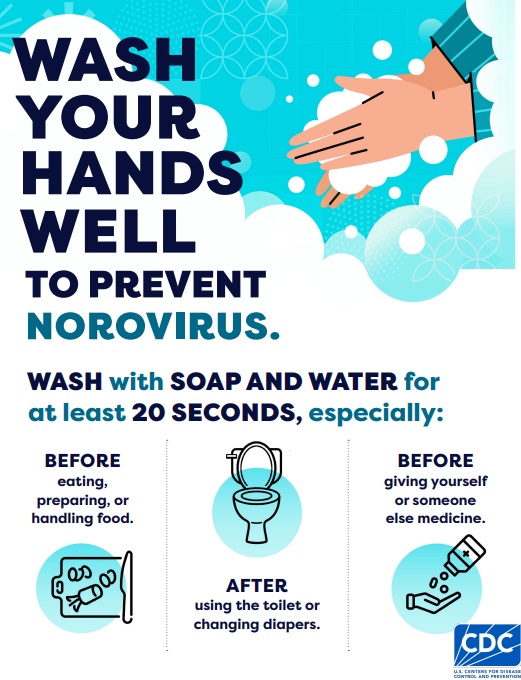Report Outbreaks
If you suspect an outbreak at your school, child care or long-term care facility, notify the Health Department 24/7 by using the Outbreak Report Form or by calling 802-863-7240.
Norovirus is a very contagious virus that causes vomiting and diarrhea. You can get sick with norovirus by eating or drinking food or liquids that are contaminated with the virus, having contact with other people or surfaces carrying the virus or swimming in contaminated water. You can help protect yourself and others from norovirus by washing your hands thoroughly with soap and water and following other prevention tips.
Symptoms usually start 12-48 hours after being exposed to the virus. The most common symptoms of norovirus are:
- diarrhea
- vomiting
- nausea
- stomach pain
Most people with norovirus get better within 1-3 days. There is no specific medicine to treat norovirus but if you have norovirus illness, you should drink plenty of liquids to prevent dehydration.
Norovirus infections can happen at any time of year, but they occur much more often during the winter months. These outbreaks are common in closed environments and group settings. In warmer months, outbreaks often occur at recreational water locations.
Prevention
Wash your hands after using the toilet or changing diapers, before making and eating food, and before giving yourself or someone else medicine.
The best way to wash your hands:
- Wet hands with water and cover all parts of hands with soap.
- Rub lathered hands together vigorously for at least 20 seconds. Be sure to lather the backs of your hands, between your fingers, and under your nails.
- Thoroughly rinse with water.
- Dry hands with a clean towel.
Norovirus can be found in your vomit or poop even before you start feeling sick. The virus can stay in your poop for two weeks or more after you feel better. It’s important to continue washing your hands often during this time.
Learn more about the importance of handwashing (CDC).
Handle and make food safely by washing fruits and vegetables before eating them and cooking shellfish thoroughly. Routinely clean and sanitize kitchen utensils, counters, and surfaces before preparing food.
If you’re sick, stay home and do not make food or care for others for at least two days after symptoms stop. This applies especially to workers in restaurants, schools, day care centers, long-term care facilities, and other places where they may expose people to the virus.
Clean and disinfect areas immediately after someone vomits or has diarrhea.


